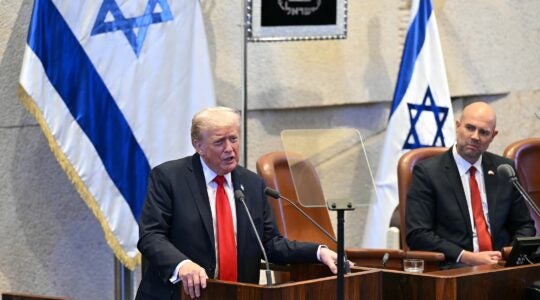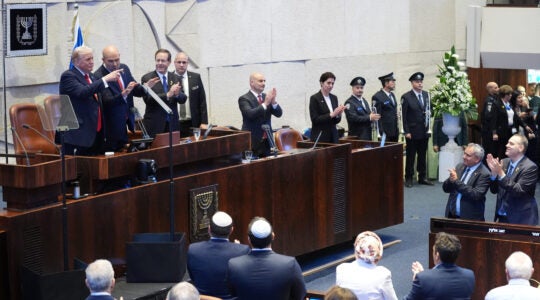NEW YORK (JTA) – Among the most innovative – and controversial – aspects of the siddur soon to be released by San Francisco’s main gay synagogue is a prayer for “unexpected intimacy.”
The new prayer is intended for meaningful encounters with strangers, including, according to some involved in the project, anonymous sexual relations.
It is featured in the forthcoming siddur created by Congregation Sha’ar Zahav, a 31-year-old synagogue in San Francisco affiliated with the Reform movement.
“In the dark, in a strange place, our father Jacob encountered a stranger with whom he grappled all night,” the prayer begins, referring to the biblical story of Jacob wrestling with the angel. “He never knew the stranger’s name, yet their encounter was a blessing, which turned Jacob into Israel and made him realize, I have seen God face-to-face.”
The prayer, titled “Kavannah for Unexpected Intimacy,” goes on to ask God – “who created passion and wove it throughout creation” – to permit the encounter to be a blessing “that allows us to both touch and see the Divine.”
Some proponents of the siddur see the prayer – included in a section of innovative blessings meant to enhance life-cycle moments – as potentially being used to elevate sexual practices that, in some quarters, are viewed as part of gay culture. But even among Jewish leaders that the gay community regards as allies, the prayer is seen as crossing a line, to the degree to which it is used to sanctify sexual activities that Judaism reviles.
Rabbi Elliot Dorff, the rector of the American Jewish University in Los Angeles, is the co-author of a groundbreaking religious edict permitting same-sex marriage and the ordination of gay and lesbian rabbis that was endorsed in 2006 by the Conservative synagogue movement.
“A one-night stand is officially an act of prostitution in the Jewish tradition,” Dorff said. “It’s not just that it’s not ideal, it’s that it really is seen as being something that a Jew ought not to engage in.”
The prayer revives an argument, implicit in communal debates about gay inclusion, over how far Jewish tradition ought to be adapted to the realities of modern Jewish life or whether it should insist on certain standards even – or perhaps especially – when they go against the grain of contemporary norms. A similar discussion took place last year after the Reform movement published a blessing over sex-change procedures – a prayer that also is included in the Sha’ar Zahav siddur.
The point of the prayer for unexpected intimacy is “that all aspects of our lives are holy if we approach them with a sense of the sacred,” said Rabbi Camille Angel of Sha’ar Zahav.
“The fact of the matter is we have emotional, sexual, intellectual encounters that are Martin Buber’s I-Thou, which ennoble us and draw us to our highest potential,” she said. “Whether they ever happen again, the experience itself can change us and be a blessing in our lives.”
In potentially sanctioning and sanctifying anonymous sexual encounters, the prayer flies in the face of theological arguments employed by Dorff and many other Reform and Conservative rabbis to justify overturning the ban on same-sex ceremonies and gay ordination.
Dorff in particular based his activism on these issues in large part on what he calls the “Jewish and social and medical need” to promote monogamous sexual relations among all people – gay and straight.
Of the new liturgy, he said, “If it’s about anonymous sex, then it’s giving something religious meaning that should not have religious meaning.”
Rabbi Steve Greenberg, an openly gay Orthodox rabbi and a leading advocate for gay and lesbian inclusion, said that while the motivation for the liturgy is understandable, it nevertheless “contorts” the idea of holiness, if applied to anonymous sex.
“The more common reality of anonymous sex is that it is a form of mutual objectification and so must be the opposite of holiness,” said Greenberg, who wrote the 2004 book “Wrestling With God and Men,” a landmark work on Judaism and homosexuality. “What is missing from this prayer is that holiness grows incrementally as we move beyond the momentary, the sensual and the strange.”
Andrew Ramer, the longtime Sha’ar Zahav member who authored the prayer, expressed deep respect for Dorff and Greenberg even as he rejected their view that anonymous sex, whether gay or straight, is inherently vile and unholy.
“In the gay community there are people who feel that part of our culture is not just having unexpected or anonymous sex, but at times really finding sacred connection there,” Ramer said. “Is it wrong to hope that in a situation where people often do objectify each other that they stop and think, you know this isn’t feeling kosher to me. I want to do this. I want to be with this other person. The passion is raging out of control, but I want to do this in a sacred way.”
The Sha’ar Zahav prayer may reflect the behavior of some Jews, but it appears to run counter to the call for renewed emphasis on Jewish sexual ethics by the leader of the movement with which the synagogue is affiliated.
In his sermon at the Reform movement’s 2005 biennial in Houston, Rabbi Eric Yoffie railed against the teenage culture of “hooking up,” which he described as a “social ethic … that severs sex from any pretense of a relationship.”
Yoffie, the president of the Union for Reform Judaism, called for greater emphasis on Jewish teachings that require love and commitment as components of sex – but he was clear-eyed about the movement’s limitations.
“The problem for our synagogues may be that we are not very good at saying ‘no’ in Reform Judaism,” Yoffie said. “We are the most creative and forward-looking movement in Jewish life, but in the realm of personal behavior, we are reluctant to ever use the word ‘forbidden.’ Yet in dealing with kids engaged in destructive behavior, the concept of autonomy leaves us unable to set limits and make sound judgments.”
Yoffie declined to comment on the Sha’ar Zahav prayer, but Rabbi Sue Ann Wasserman, who directs the movement’s department of Worship, Music and Religious Living, echoed the thinking of the siddur’s editors in stressing the prayer’s response to the reality of lived experience.
“I think one could clearly say in a Jewish values system, anonymous sex is not the preferred form of intimacy,” Wasserman told JTA. “I don’t think anybody would say otherwise. I guess sometimes you look at the reality of people’s lives and you hope that you can create opportunities for them to grow and for them to see alternatives. And maybe this is part of it.”
Leslie Kane, a member of Sha’ar Zahav and one of the siddur’s three editors (all of whom are straight) sounded another theme of the Reform movement – personal choice – in defending the prayer’s inclusion.
“I don’t think the prayer is looking to get official hechsher from a Jewish organization,” Kane said. “This is all about what the person, him or herself, wants to recognize.”
As with other recent efforts to modify traditional liturgy to reflect contemporary realities, the development of the Sha’ar Zahav siddur was a deeply collaborative process. Those involved in the process told JTA that the anonymous sex prayer was among the most contentious issues that emerged, though not as contentious as a discussion over whether to include a prayer of mourning for a lost pet. The pet prayer is not slated for inclusion.
Ramer, who describes himself as “fiercely monogamous” and politically conservative, stressed that the prayer was not intended solely for gays and lesbians. He also emphasized that it need not refer solely to encounters of a sexual nature, but to any exchange with a stranger that was deemed meaningful.
“Isn’t this one of the things we’re told the most, to honor strangers?” Ramer asked. “In an anonymous act, this is our chance to recognize the sacredness.”
JTA has documented Jewish history in real-time for over a century. Keep our journalism strong by joining us in supporting independent, award-winning reporting.





